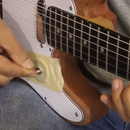Introduction: Computer Volume Control Knob
If you enjoy listening to music on your computer, but often need to silence and restart it when watching media, hitting Fn+k+F12+g every time just isn't going to cut it. Plus adjusting volume with buttons? No one has time for that!
May I present my Computer volume shortcut knob! While meant to mute music and adjust volume, this could really be used to control anything. A video on the process is available here, and I'll embed it at the end.
Step 1: Encoder/electronics
To interface with the PC, I chose a Trinket board from Adafruit. After a very brief amount of searching, I found that someone else had already thought of this, providing code and schematics.
Originally, I thought I’d use a series of resistors in order for me to use multiple buttons, but this was easier said than done due to the way the board is made. Given this, I could have done away with the yellow button, and just used
the one built into the encoder. I did end up keeping it, and it for a nice display in the video.
Note me testing out my encoder setup with LEDs in the second picture.
Step 2: Enclosure
The enclosure, however, is original, and you can find my drawing in the included DXF.
It's cut from two pieces of MDF that sandwich the PCB in between, allowing space above and below it for components. The top part and button is made out of white acrylic.
I didn't leave enough clearance for the top, so I ended up having to do a bit of manual work on my mill. If you decide to make one yourself, you may want to re-examine the drawing.
Attachments
Step 3: Button
Here's how the square button fits on. Used some cyanoacrylate glue to keep things in place. Also, I used a scrap of MDF to elevate the button to a good position.
Step 4: Paint and Glue
Painted the MDF black, then glued and clamped things together.
Step 5: Program and Use
Program the device and you should have a usable shortcut knob. I've included my code, lightly modified from the Adafruit tutorial linked earlier.
Attachments
Step 6: Video
As promised, here's the video of the process. I really enjoy how the edges of the knob feel against my finger/thumb If you like the video, I'd invite you to subscribe to my channel via this link to see what comes next!
I may make an upgraded one with a Pro Micro or similar board, which features enough inputs for more shortcut keys and the like. Perhaps LED feedback would be good as well - so many ideas, hard to know which ones to actually make!

Participated in the
Pocket-Sized Contest








![Tim's Mechanical Spider Leg [LU9685-20CU]](https://content.instructables.com/FFB/5R4I/LVKZ6G6R/FFB5R4ILVKZ6G6R.png?auto=webp&crop=1.2%3A1&frame=1&width=306)





